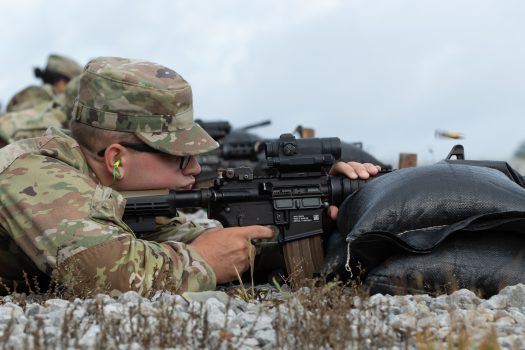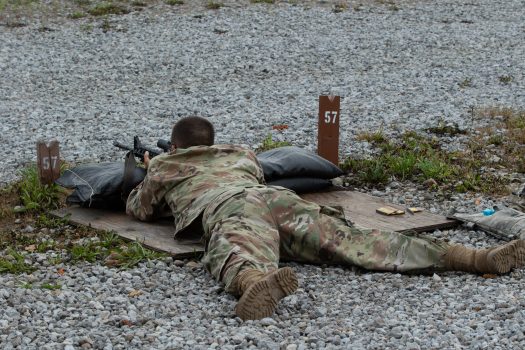Before Weapons Qualification, Cadets have to go through Weapons Group Zero training which is somewhat of a practice round.
Staff Sgt. Quinton Tucker, a lane safety non-commissioned officer from 3rd Calvary Regiment, Fort Hood, Texas, talked about how the training would go. Each Cadet is going to shoot ten rounds at each target, five at a time. The first target is for the Cadets to group their weapons. The second target is where the Cadets will zero their weapons. Lastly, the third target will be where the Cadets confirm zero.

The Cadets are only shooting at targets 25 meters away and if the Cadets can shoot and zero at this distance the bullet’s route will be able to hit a target down range at 300 meters.
“This is a calm, steady environment for them to be able to shoot calmly, get their weapons zeroed and be able to confirm their zeros so that whenever they are in a war fighting situation they don’t have to worry about shooting and missing the target,” said Tucker.
One of the Cadets at this training agreed with Tucker. Cadet Alicia Williams from Campbell University, who has 12 and a half years of prior service as a combat medic and a civil affairs specialist, talked about why it is important to know how to group and zero your weapon.
“Consistency is really important because it creates muscle memory. You know when crap kind of hits the fan you are always going to revert back to that muscle memory,” said Williams. “So, if you are consistent in your training and consistent in enhancing your skills, then you’ll be consistent and you’re going to do it the right way when you are not in your natural element, when you’re nervous or have anxiety when things are kind of going wrong.”

No matter what job field the Cadets go into, this training is important for everyone.
“You can be finance, but once you deploy or get on forward operating base and then they need someone, you always have to remember you’re a soldier first,” said Cadet David Spence from Campbell University, who has eight years of prior service as a generator mechanic. So, you have to apply what you learned, first the fundamentals and just know the basics as a soldier.”
No matter how experienced a Cadet is with shooting there are still basic steps to remember.
“Get that sight picture, get that natural body position and then to just really relax and squeeze,” said Williams. “Just make sure that when you shoot it should surprise you. You shouldn’t anticipate it because then you’ll pull the weapon.”
Cadet Colton Klaudt, a Cadet at Montana State University has been shooting all his life, from practice at the gun range to hunting on his personal time, but even he learned something new.
“Body position changes point of impact,” said Klaudt. “Even though your rifle might be zeroed for one shooting position, sometimes when you move your body it will change your point of impact, but the gun is still accurate, it’s about as accurate as you are.”




